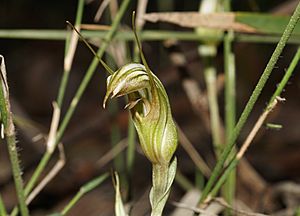Snake-tongue greenhood facts for kids
Quick facts for kids Snake-tongue greenhood |
|
|---|---|
 |
|
| Pterostylis ophioglossa in Columbey National Park near Dungog | |
| Scientific classification | |
| Genus: |
Pterostylis
|
| Species: |
ophioglossa
|
| Synonyms | |
|
|
The snake-tongue greenhood (scientific name: Pterostylis ophioglossa) is a special type of orchid. It grows only in eastern Australia. This plant gets its common name because a part of its flower looks a bit like a snake's tongue. It has a group of leaves at its base. The plant produces a single flower that is dull green, white, and brown.
What Does It Look Like?
The snake-tongue greenhood is a plant that grows on land. It is a perennial plant, meaning it lives for more than two years. It is also deciduous, so its leaves fall off during certain seasons.
This plant has an underground storage part called a tuber. It also has a group of four to six egg-shaped leaves at its base. Each leaf is about 15–25 mm (0.6–1 in) long and 4–20 mm (0.2–0.8 in) wide.
When the plant is ready to flower, it grows a single flower stem. This stem can be 100–250 mm (4–10 in) tall. The flower itself is dull green, brown, and white. It measures 25–30 mm (0.98–1.2 in) long and 10–13 mm (0.4–0.5 in) wide. The flower leans forward, giving it a unique shape.
The top part of the flower, called the "galea," looks like a hood. It is formed by the top sepal and two petals joining together. This hood curves forward over the central part of the flower, which is called the column. The top sepal is a bit longer than the petals and has a pointed tip about 2–3 mm (0.08–0.1 in) long.
Below the galea, there are two side sepals. They have a flat, U-shaped space between them. From this space, two thread-like tips stand upright. These tips are about 22–30 mm (0.9–1 in) long.
The most interesting part is the labellum, which is like the orchid's "lip." It sticks out above the U-shaped space. The labellum is 13–16 mm (0.5–0.6 in) long and about 3 mm (0.1 in) wide. It is curved, brown, and has a deep notch at its end, which is why it's called "snake-tongue." This orchid usually flowers between April and July.
How It Got Its Name
The snake-tongue greenhood was first officially described in 1810. A famous botanist named Robert Brown wrote about it in his book Prodromus Florae Novae Hollandiae et Insulae Van Diemen.
The scientific name, ophioglossa, comes from two ancient Greek words. The word ophis (ὄφις) means "snake." The word glōssa (γλῶσσα) means "tongue." So, the name perfectly describes the flower's unique shape!
Where Does It Live?
The snake-tongue greenhood grows in eastern Australia. You can find it in sheltered spots within forests and scrubland. It lives in coastal areas. Its range stretches from Sydney in New South Wales all the way up to Eungella in Queensland.

